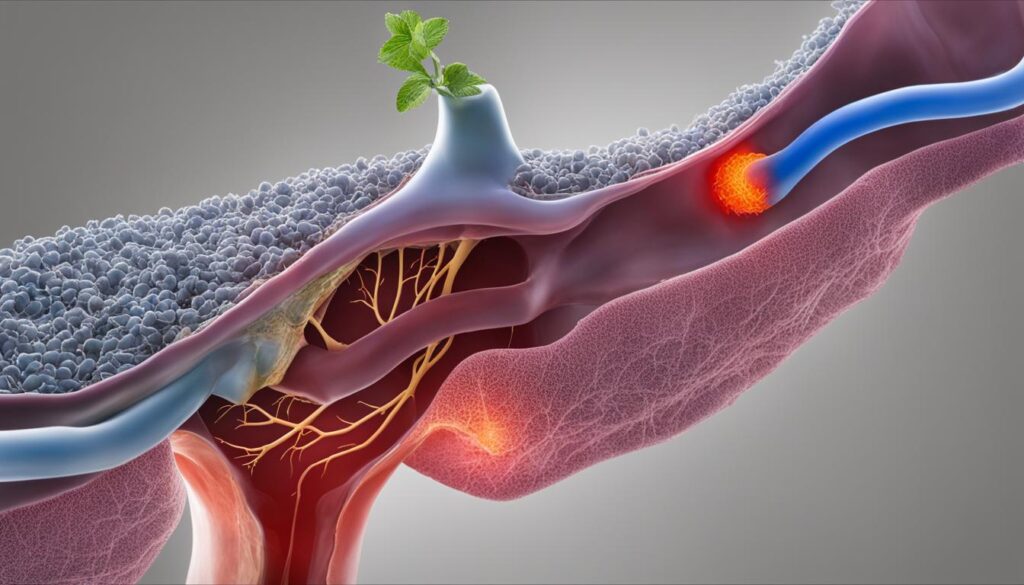Welcome to our comprehensive guide on cholangitis, a liver disease characterized by inflammation in the bile ducts. In this article, we will explore the symptoms, causes, diagnosis, and treatment options for cholangitis.
Table of Contents
ToggleCholangitis can manifest in different forms, including primary biliary cholangitis (PBC), primary sclerosing cholangitis (PSC), secondary cholangitis, and immune cholangitis. Each type may present with varying symptoms and require specific treatment approaches.
Some common symptoms of cholangitis include fatigue, itchy skin, dry eyes, pain in the upper right side of the abdomen, night sweats, swollen feet and ankles, and more. Acute cholangitis, which occurs suddenly, can cause additional symptoms such as a high fever, chills, nausea, vomiting, and yellowing of the skin and eyes.
Diagnosing cholangitis involves a series of tests and scans, including blood tests, ultrasound, CT scans, magnetic resonance cholangiopancreatography (MRCP), endoscopic retrograde cholangiopancreatography (ERCP), and percutaneous transhepatic cholangiography (PTC).
Treatment for cholangitis depends on the type and severity of the condition. It may include antibiotics, intravenous fluids, bile duct drainage, endoscopic therapy, percutaneous therapy, surgery, or, in severe cases, liver transplants.
It’s important to note that cholangitis can lead to complications, such as liver damage, gallstones, enlarged spleen and veins, blood infection, and other related conditions. Prompt diagnosis and appropriate treatment are crucial for managing cholangitis effectively.
Throughout this article, we will delve deeper into the symptoms, causes, diagnosis, and treatment options for cholangitis. By the end, you will have a comprehensive understanding of this liver disease and its management.
Symptoms of Cholangitis
The symptoms of cholangitis can vary depending on the type and duration of the condition. Some common early symptoms of chronic cholangitis may include fatigue, itchy skin, dry eyes, and dry mouth. As chronic cholangitis progresses, additional symptoms may develop, such as:
- Pain in the upper right side
- Night sweats
- Swollen feet and ankles
- Darkening of the skin (hyperpigmentation)
- Muscle pain
- Bone or joint pain
- Bloating
- Fat deposits in the skin around the eyes and eyelids, as well as the elbows, knees, palms, and soles of the feet
- Diarrhea or greasy bowel movements
- Clay-colored bowel movements
- Weight loss
- Mood changes and memory problems
Acute cholangitis may also present with sudden symptoms including:
- A high fever for more than 24 hours
- Pain or cramps in the upper right side of the abdomen
- Chills
- Nausea
- Vomiting
- Back pain
- Yellowing of the skin and eyes (jaundice)
- Dark urine
- Low blood pressure
- Confusion

Causes of Cholangitis
Cholangitis, a type of liver disease characterized by inflammation in the bile duct, can have various causes. Understanding the underlying factors contributing to cholangitis is crucial for effective management and prevention of the condition.
Chronic Cholangitis:
In cases of chronic cholangitis, one of the main causes is an autoimmune disease. The body’s immune system mistakenly attacks the bile ducts, leading to inflammation. Over time, this chronic inflammation can cause scarring and narrowing of the ducts, potentially resulting in blockages.
Acute Cholangitis:
Acute cholangitis, on the other hand, can be triggered by various factors. Bacterial infections, such as those caused by Escherichia coli or Klebsiella, can lead to acute cholangitis. Additionally, gallstones can obstruct the bile ducts, causing inflammation. Other blockages, such as tumors or strictures, may also contribute to the development of acute cholangitis.
Environmental factors can also play a role in the onset of acute cholangitis. Infections, exposure to certain chemicals, or smoking can increase the risk of developing the condition.
Risk Factors:
Several risk factors can increase the likelihood of developing cholangitis. Gender is a significant factor, with primary sclerosing cholangitis being more common in men, while primary biliary cholangitis is more prevalent in women. Age can also contribute to the risk, as cholangitis typically occurs in adults between the ages of 30 and 50. Additionally, genetics may play a role, as cholangitis often runs in families.

By understanding the causes and risk factors of cholangitis, healthcare professionals can provide targeted interventions and preventive measures to manage the condition effectively.
Diagnosing Cholangitis
To accurately diagnose cholangitis, a range of tests and scans are utilized. These investigative procedures provide valuable insights into the presence of cholangitis and its severity. The diagnostic process involves a comprehensive evaluation to confirm the condition and determine the most appropriate course of treatment.
Blood Tests
Commonly employed in the diagnosis of cholangitis, blood tests play a crucial role in providing insights into infection and liver function. Two key blood tests often conducted are:
- Complete Blood Count (CBC): This test helps identify signs of infection, such as an elevated white blood cell count, which is indicative of inflammation.
- Liver Function Tests: These tests measure specific enzymes and proteins in the blood, highlighting any impairment in liver function.
Additional Diagnostic Measures
Alongside blood tests, various imaging tests aid in visualizing the liver, gallbladder, and bile ducts, facilitating the identification of blockages or abnormalities. Some imaging tests that may be used include:
- Ultrasound: A non-invasive procedure that uses sound waves to create images of the internal organs, helping assess the structure of the liver, gallbladder, and bile ducts.
- CT Scan: This specialized X-ray technique produces detailed cross-sectional images of the abdomen, assisting in detecting any abnormalities in the liver and bile ducts.
- Magnetic Resonance Cholangiopancreatography (MRCP): Utilizing powerful magnets and radio waves, MRCP generates detailed images of the bile ducts, aiding in the detection of blockages or narrowing.
- Endoscopic Retrograde Cholangiopancreatography (ERCP): An endoscopic procedure that combines imaging and therapy, allowing for the visualization and clearance of the bile ducts.
- Percutaneous Transhepatic Cholangiography (PTC): A minimally invasive procedure involving the injection of contrast dye into the liver to obtain detailed X-ray images of the bile ducts.
Other tests, such as urine, bile, or stool samples, may be required to provide additional information essential for a comprehensive diagnosis.
It is crucial to undergo the recommended tests and scans to ensure an accurate cholangitis diagnosis. Early detection and prompt medical intervention can significantly improve the prognosis and outcomes for individuals affected by this condition.

| Diagnostic Measures | Description |
|---|---|
| Blood Tests (CBC and Liver Function Tests) | Assess infection and liver function by analyzing blood samples. |
| Ultrasound | Non-invasive imaging technique that uses sound waves to create images of the liver, gallbladder, and bile ducts. |
| CT Scan | A specialized X-ray technique that provides detailed images of the abdomen, aiding in detecting abnormalities in the liver and bile ducts. |
| Magnetic Resonance Cholangiopancreatography (MRCP) | Uses powerful magnets and radio waves to produce detailed images of the bile ducts, facilitating the identification of blockages or narrowing. |
| Endoscopic Retrograde Cholangiopancreatography (ERCP) | Combines imaging and therapy to visualize and clear the bile ducts and potentially remove any blockages. |
| Percutaneous Transhepatic Cholangiography (PTC) | Minimally invasive procedure involving the injection of contrast dye into the liver to obtain detailed X-ray images of the bile ducts. |
| Other Tests (Urine, Bile, or Stool Samples) | Gather additional information through samples to assist in making an accurate diagnosis. |
Treatment and Complications of Cholangitis
The treatment for cholangitis depends on the type and severity of the condition. In the case of acute cholangitis, immediate medical attention is crucial. Treatment commonly involves the use of antibiotics and intravenous fluids to combat the infection. Additionally, procedures like bile duct drainage may be necessary to alleviate blockages and promote proper bile flow.
For chronic cholangitis, the focus is on symptom management and monitoring liver function. Various treatment options are available, depending on the individual case. These options include endoscopic therapy, percutaneous therapy, and surgery to open blocked bile ducts. In severe cases where the liver is severely damaged, a liver transplant might be necessary for proper treatment.
While managing cholangitis, it is essential to be aware of potential complications that may arise. Complications can include liver scarring, commonly known as cirrhosis, the development of gallstones, enlargement of the spleen and veins, and the risk of blood infection or sepsis. To address these complications, additional treatment and care may be required, such as nutritional support, medications to manage bone weakness and high blood pressure, and continuous monitoring of liver function.
In summary, prompt and appropriate treatment plays a crucial role in managing cholangitis effectively. Whether it is acute or chronic cholangitis, seeking medical assistance is vital to prevent further complications and promote healing. The complications associated with cholangitis can be severe, emphasizing the need for diligent management and ongoing care.
FAQ
What is cholangitis?
Cholangitis is inflammation in the bile duct, which is a type of liver disease.
What are the symptoms of cholangitis?
The symptoms of cholangitis vary depending on the type, but they may include fatigue, itchy skin, dry eyes, pain in the upper right side, night sweats, swollen feet and ankles, and more.
What are the symptoms of acute cholangitis?
Acute cholangitis happens suddenly and can cause symptoms like a high fever, pain in the upper right side of the abdomen, chills, nausea, vomiting, and yellowing of the skin and eyes.
What are the symptoms of chronic cholangitis?
Chronic cholangitis occurs slowly over time and can cause symptoms such as pain in the upper right side, muscle and joint pain, weight loss, and mood changes.
What are the causes of cholangitis?
The causes of cholangitis can include autoimmune disease, bacterial infections, gallstones, blockages, tumors, and environmental factors.
How is cholangitis diagnosed?
Diagnosis is done through various tests and scans, such as blood tests, ultrasound, CT scan, magnetic resonance cholangiopancreatography (MRCP), endoscopic retrograde cholangiopancreatography (ERCP), and percutaneous transhepatic cholangiography (PTC).
What is the treatment for cholangitis?
Treatment for cholangitis depends on the type and may involve antibiotics, intravenous fluids, bile duct drainage, endoscopic therapy, percutaneous therapy, surgery, or liver transplants.
What are the complications of cholangitis?
Complications of cholangitis can include liver damage, gallstones, enlarged spleen and veins, blood infection, and other related conditions.


